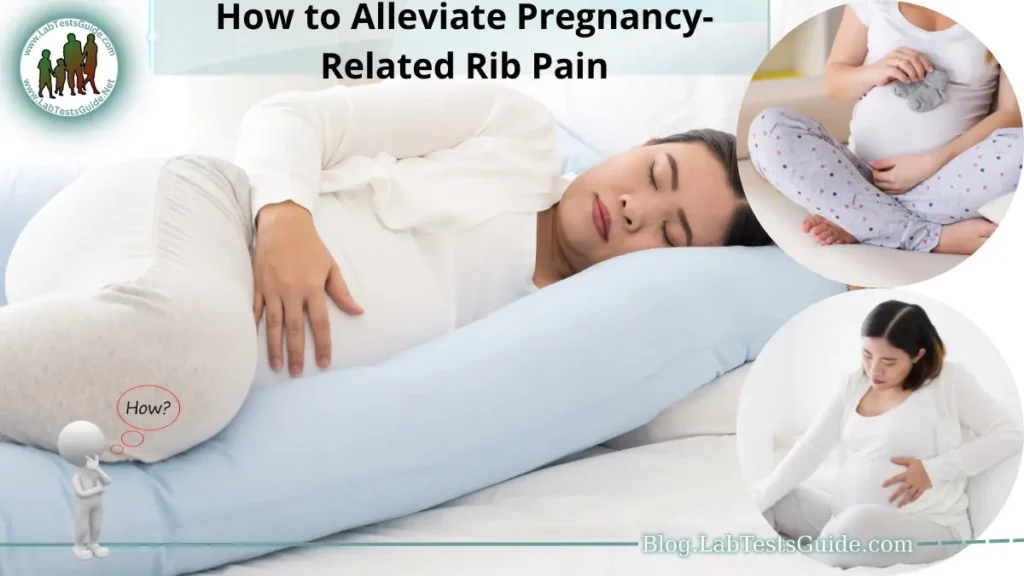Pregnancy is a beautiful and transformative journey, but it can also bring about various discomforts and pains. One common issue experienced by some pregnant women is rib pain. As the baby grows and the uterus expands, it can exert pressure on the ribs, leading to discomfort, aching, or sharp pain in the ribcage area. While pregnancy-related rib pain is typically temporary and harmless, it can significantly impact a woman’s comfort and quality of life during pregnancy.

This guide aims to provide helpful information and strategies to alleviate pregnancy-related rib pain. It will explore the causes and symptoms of rib pain during pregnancy, discuss the anatomical changes that occur, and offer a range of techniques and lifestyle modifications that can provide relief. It’s important to note that every pregnancy is unique, and what works for one person may not work for another. Therefore, it’s crucial to consult with a healthcare provider for personalized advice and to ensure that any recommended interventions align with your specific situation.
Understanding the Anatomy:
- Expansion of the Rib Cage: As the uterus expands to accommodate the growing baby, it pushes against the diaphragm and gradually elevates the rib cage. This upward pressure can cause the ribs to flare out, leading to discomfort or pain.
- Relaxation of Ligaments: Pregnancy hormones, particularly relaxin, cause ligaments and connective tissues in the body to loosen. This allows for greater flexibility in the pelvic region for childbirth but can also affect the stability of the rib cage, potentially leading to pain or discomfort.
- Postural Changes: As pregnancy progresses, changes in posture are common. The center of gravity shifts forward, and the curvature of the spine may increase to accommodate the growing belly.
Common Reasons for Rib Pain During Pregnancy:
- Pressure from the Uterus: As the uterus expands, it can put pressure on the ribs, particularly the lower ribs on the right side. This pressure can cause pain or discomfort in the ribcage area.
- Diaphragm Compression: The upward pressure from the expanding uterus can compress the diaphragm, the muscle responsible for breathing. This compression can lead to shallow breathing and contribute to rib pain.
- Ligament Stretching: The hormonal changes during pregnancy can cause the ligaments and connective tissues in the rib cage area to stretch and become more flexible. This stretching can result in discomfort or pain.
- Poor Posture: As the body adjusts to the changes brought about by pregnancy, it’s common for posture to be affected. Poor posture, such as slouching or hunching forward, can strain the rib cage and exacerbate rib pain.
Understanding the anatomical changes and the common reasons for rib pain during pregnancy lays the foundation for implementing strategies to alleviate discomfort. In the following sections, we will explore various techniques, lifestyle modifications, and support options that can help alleviate pregnancy-related rib pain and enhance overall comfort during this special time.
Seeking Medical Advice:
Here are some key considerations when seeking medical advice for pregnancy-related rib pain.
- Timing: If you experience persistent or severe rib pain, it’s important to consult with your healthcare provider as soon as possible.
- Medical History: Inform your healthcare provider about any pre-existing medical conditions, such as musculoskeletal issues or respiratory problems, as they may contribute to or interact with the rib pain.
- Physical Examination: Your healthcare provider may perform a physical examination to assess your rib cage, spine alignment, and overall posture.
- Diagnostic Tests: In some cases, your healthcare provider may order diagnostic tests to rule out other potential causes of rib pain, such as imaging studies (X-rays, ultrasound) or blood tests.
- Medication Considerations: If necessary, your healthcare provider may recommend suitable pain relief options, taking into account the safety of medications during pregnancy.
Remember, every pregnancy is unique, and the advice provided by your healthcare provider will be tailored to your individual needs. Open communication with your provider about your symptoms, concerns, and preferences will ensure that you receive appropriate care and guidance for managing pregnancy-related rib pain effectively.
Self-Care Techniques:
Here are some self-care techniques you can try.
Applying Heat or Cold Packs:
- Place a warm compress or heating pad on the affected area to help relax the muscles and reduce pain.
- Alternatively, applying a cold pack wrapped in a thin cloth can help numb the area and reduce inflammation. Use cold therapy for short durations and avoid direct contact with the skin.
Maintaining Proper Posture:
- Be mindful of your posture throughout the day, especially when sitting or standing. Sit up straight, with your shoulders relaxed and your back supported.
- Avoid slouching or hunching forward, as this can strain the rib cage and exacerbate pain.
- Consider using ergonomic chairs or pregnancy support pillows to maintain good posture and provide additional comfort.
Gentle Stretching Exercises:
- Consult with your healthcare provider or a prenatal exercise specialist for specific stretching exercises that can help relieve rib pain.
- Gentle stretches targeting the chest, back, and shoulder muscles can help reduce tension in the rib cage area.
- Incorporate deep breathing exercises into your stretches to promote relaxation and increase oxygen flow.
Wearing Supportive Bras:
- Invest in well-fitting, supportive bras that provide proper breast and rib cage support.
- Look for bras with wider straps and a supportive band under the bust to distribute weight evenly and alleviate pressure on the ribs.
Using Pregnancy Pillows for Support:
- Utilize pregnancy pillows to provide support and alleviate pressure on the rib cage while sleeping or resting.
- Experiment with different pillow configurations to find a comfortable position that relieves rib pain.
Remember to listen to your body and modify or discontinue any exercises or techniques that cause discomfort. It’s important to find the right balance of rest, movement, and support to alleviate rib pain during pregnancy. If the pain persists or worsens, consult with your healthcare provider for further guidance and support.
Breathing and Relaxation Techniques:
Here are some techniques you can try.
Deep Breathing Exercises:
- Find a comfortable seated or lying position.
- Place one hand on your chest and the other on your belly.
- Take slow, deep breaths in through your nose, allowing your belly to rise as you inhale.
- Exhale slowly through your mouth, letting your belly fall.
- Focus on deepening and slowing down your breath, promoting relaxation and reducing tension in the ribcage area.
- You can practice deep breathing exercises throughout the day or whenever you experience rib pain.
Prenatal Yoga and Meditation:
- Prenatal yoga and meditation classes can teach you specific techniques to relax your body and mind.
- Yoga poses and gentle stretches can help improve posture, release tension in the rib cage, and promote overall relaxation.
- Meditation and mindfulness exercises can help you focus on the present moment, reduce stress, and alleviate pain and discomfort.
Techniques for Stress and Pain Management:
- Engage in activities that help you relax and reduce stress, such as listening to calming music, taking warm baths, or practicing guided imagery.
- Practice progressive muscle relaxation, where you consciously tense and then release different muscle groups in your body, starting from your toes and moving upward. This can help promote overall relaxation and alleviate tension in the ribcage area.
Explore complementary therapies such as aromatherapy, using essential oils like lavender or chamomile, which are known for their relaxation properties. However, consult with your healthcare provider before using essential oils during pregnancy.
Remember to consult with your healthcare provider before starting any new exercise or relaxation routine to ensure it is safe and suitable for your individual circumstances.
Lifestyle Modifications:
Here are some lifestyle modifications to consider.
Resting and Avoiding Strenuous Activities:
- Take regular breaks throughout the day to rest and allow your body to recover.
- Avoid activities that require repetitive or excessive movements of the upper body, as they can strain the rib cage and exacerbate pain.
- Pace yourself and listen to your body’s signals to avoid overexertion.
Using Pillows for Elevation and Support During Sleep:
- Elevate your upper body slightly during sleep by using extra pillows or a pregnancy pillow.
- This elevation can help reduce pressure on the rib cage and promote better alignment.
Wearing Loose-Fitting Clothing:
- Opt for loose-fitting, comfortable clothing that doesn’t constrict or put unnecessary pressure on the rib cage.
- Avoid tight bras, belts, or waistbands that can exacerbate rib pain.
Trying Gentle Massages or Prenatal Chiropractic Care:
- Gentle massages can help relieve muscle tension and promote relaxation in the ribcage area.
- Consider seeking the services of a prenatal chiropractor who can provide specialized care to address any misalignments or discomfort in the rib cage and spine.
Practicing Good Body Mechanics:
- Be mindful of your body mechanics during daily activities, such as lifting objects or getting in and out of a car.
- Bend at the knees and hips rather than straining the upper body and rib cage.
- Ask for assistance when needed to avoid putting unnecessary strain on the rib cage.
Remember, every pregnancy is unique, and it’s essential to listen to your body and make modifications that work best for you. If you have any concerns or questions about specific lifestyle modifications, consult with your healthcare provider for guidance and personalized recommendations.
Medications and Pain Relief:
Here are some considerations regarding medications and pain relief during pregnancy.
Over-the-Counter (OTC) Pain Relievers:
- Acetaminophen (Tylenol) is generally considered safe for use during pregnancy and is often recommended for mild to moderate pain relief.
- Nonsteroidal anti-inflammatory drugs (NSAIDs) like ibuprofen (Advil, Motrin) and naproxen (Aleve) should be used with caution during pregnancy and only under the guidance of a healthcare provider, as they may have potential risks.
Topical Creams or Ointments:
- Topical pain relief options, such as creams or ointments containing ingredients like menthol or camphor, can provide localized relief for muscle aches and discomfort.
- Always read the labels and consult with your healthcare provider before using any topical products during pregnancy to ensure they are safe and appropriate for your situation.
Prescription Medications and Considerations:
- In some cases, when non-medication approaches are insufficient, your healthcare provider may prescribe specific pain medications to manage severe or chronic pain.
- It’s important to discuss the potential risks and benefits of any prescribed medications with your healthcare provider and ensure they are safe to use during pregnancy.
Remember, self-medication or using medications without proper medical advice can pose risks to both you and your baby. Always consult with your healthcare provider before taking any medications, including over-the-counter options, to ensure their safety and appropriateness for your specific situation.
Alternative Therapies:
Here are some alternative therapies to consider.
Prenatal Massage:
- Prenatal massage is specifically designed to address the needs of pregnant women.
- A trained massage therapist can apply gentle pressure and techniques to relieve muscle tension, improve circulation, and promote relaxation.
- Ensure the massage therapist is experienced in providing prenatal massages and communicates with your healthcare provider about any specific areas of concern.
Chiropractic Care:
- Prenatal chiropractic care focuses on gentle adjustments to the spine and joints to alleviate pain and improve alignment.
- A chiropractor experienced in prenatal care can provide targeted adjustments to address rib pain and associated musculoskeletal issues.
- Always consult with your healthcare provider before seeking chiropractic care, and ensure the chiropractor has expertise in working with pregnant women.
Physical Therapy:
- A physical therapist with experience in prenatal care can provide targeted exercises, stretches, and techniques to alleviate rib pain and improve posture.
- They can also address any underlying musculoskeletal imbalances that may contribute to the discomfort.
- Working with a physical therapist can help you develop a personalized plan to manage rib pain throughout your pregnancy.
Hydrotherapy:
- Hydrotherapy involves using water for therapeutic purposes, such as warm baths, showers, or pools.
- Soaking in a warm bath or using a warm water jet in the shower can help relax muscles and provide temporary pain relief.
- Always ensure the water temperature is safe and comfortable for you and avoid hot tubs or saunas during pregnancy.
These alternative therapies can be used in conjunction with other self-care techniques to provide relief from pregnancy-related rib pain. However, it’s important to consult with your healthcare provider and seek services from qualified practitioners who have experience working with pregnant women.
Conclusion:
Pregnancy-related rib pain is a common discomfort experienced by many pregnant women. While it is generally considered a normal part of pregnancy, it can still be challenging to cope with. This article has provided an overview of various strategies to alleviate pregnancy-related rib pain.
Understanding the anatomy of the rib cage and how pregnancy affects it can help you gain insight into the underlying causes of the pain. Seeking medical advice is crucial to ensure that the pain is not indicative of an underlying medical condition and to receive personalized guidance.
Self-care techniques, such as applying heat or cold packs, maintaining proper posture, gentle stretching exercises, wearing supportive bras, and using pregnancy pillows, can provide relief and promote comfort.
Breathing and relaxation techniques, such as deep breathing exercises, prenatal yoga, and meditation, can help relax the body, reduce muscle tension, and alleviate rib pain.
Lifestyle modifications, including resting, using pillows for support during sleep, wearing loose-fitting clothing, trying gentle massages or prenatal chiropractic care, and practicing good body mechanics, can further contribute to pain management.
When considering medications and pain relief, it is crucial to consult with your healthcare provider for guidance on safe options during pregnancy. Additionally, alternative therapies like prenatal massage, acupuncture, chiropractic care, physical therapy, and hydrotherapy can be explored under the guidance of healthcare professionals.
Coping strategies and emotional support play a vital role in managing pregnancy-related rib pain. Seeking support from loved ones, joining support groups, practicing stress-management techniques, and considering professional counseling can help you navigate the physical and emotional challenges associated with rib pain during pregnancy.
Remember, every pregnancy is unique, and it’s important to consult with your healthcare provider for personalized advice and recommendations based on your individual circumstances.






